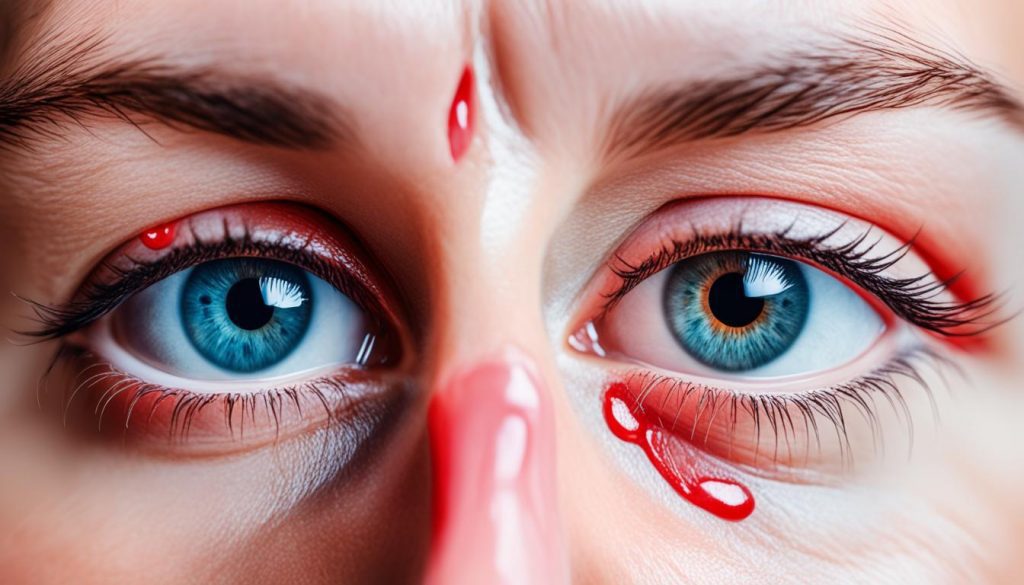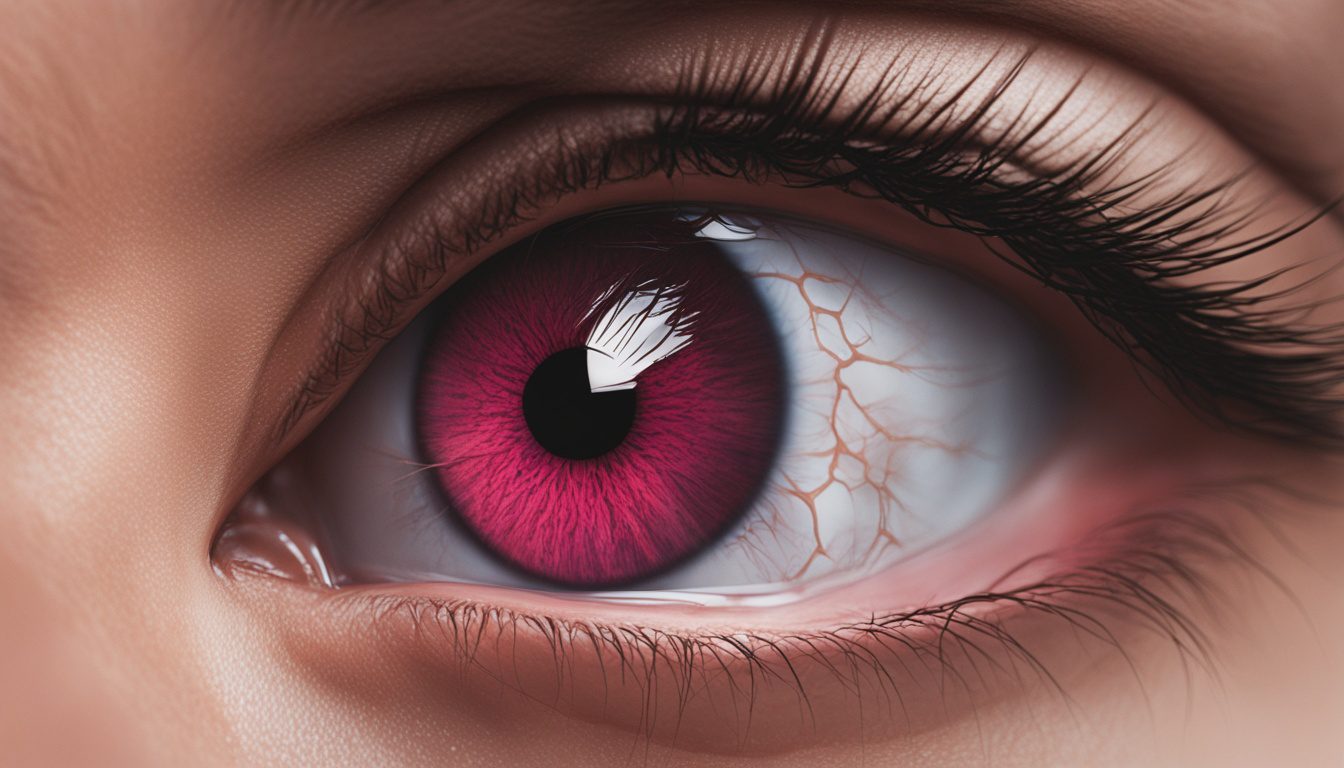A blocked tear duct, or dacryostenosis, happens when the ducts that drain tears to the throat get clogged. This leads to constant tearing, watery eyes, and sticky eye discharge. Though most blocked tear ducts get better by themselves by age one, some need surgery like tear probing. Yet, stem cell therapy is a new treatment being studied for this issue.
Key Takeaways:
- Blocked tear ducts can cause constant tearing and watery eyes.
- Most cases of blocked tear ducts resolve on their own by the age of one.
- Surgical intervention, such as tear probing, may be necessary for persistent cases.
- Stem cell therapy is being researched as an innovative treatment option for blocked tear ducts.
- Further studies and clinical trials are needed to fully understand the effectiveness and safety of stem cell therapy for this condition.
Causes of Blocked Tear Ducts
Blocked tear ducts can happen for many reasons. This includes things like being born with a small tear duct or a blockage caused by a membrane. These issues can stop tears from draining the way they should.
Some babies come into the world with tear ducts that are too tight. This makes it easier for blockages to happen. Also, a membrane might block the tear duct. Babies don’t start making tears until they are about two weeks old. So, signs of a blocked tear duct might not show up right away.
It’s very important to know why tear ducts get blocked. This helps doctors figure out the right way to fix it. Let’s now look at what symptoms and problems this condition can lead to.
| Cause of Blocked Tear Ducts | Description |
|---|---|
| Congenital Abnormalities | Conditions like a narrow tear duct or a membrane obstruction can be present at birth, causing blockages in the nasolacrimal duct. |
| Nasolacrimal Duct Obstruction | An obstruction within the tear ducts can prevent the normal flow of tears, leading to a blocked tear duct. |
Symptoms and Complications of Blocked Tear Ducts
A blocked tear duct can lead to watery eyes and frequent eye infections. Knowing these symptoms is key to getting the right help quickly.
Common Symptoms
- Epiphora: The main sign of a blocked tear duct is epiphora. This means having teary or watery eyes. It can happen all the time or just sometimes.
- Sticky Discharge and Crusty Matters: Babies with this problem might get sticky stuff or crust in their eyes. This is usually seen when they wake up.
Complications
If not treated, blocked tear ducts can cause more issues:
- Redness Around the Eyes: The skin around the eyes might get red and sore because of irritation.
- Swelling and Tenderness: The area around the tear duct can swell up and be tender. This can be uncomfortable.
- Recurrent Eye Infections: Blocked tear ducts can lead to eye infections like conjunctivitis. These can make your eyes red and sore, and cause discharge.
If you or your kid shows any symptoms, see a doctor. Getting help early can stop more problems and keep your eyes healthy.
Home Remedies for Blocked Tear Ducts
Often, blocked tear ducts in babies get better on their own. Some home remedies can help ease symptoms.
- Massage: Gently massaging between the nose and the eye’s inner corner can help. It helps clear the block and starts tear flow. Be gentle to avoid discomfort.
- Hygiene: Keeping the baby’s eyes clean is key. Wipe their eyes and eyelids with a clean towel every day. This prevents infections by removing debris and discharge.
Trying these remedies might help the healing of blocked tear ducts. But, watch the condition and consult a doctor if things don’t improve or get worse.
| Treatment | Effectiveness | Safety |
|---|---|---|
| Massage | Can be effective in unblocking tear ducts | Safe when performed gently |
| Hygiene | Helps prevent infections and reduce symptoms | Safe and recommended for daily care |

Surgical Treatment for Blocked Tear Ducts
If a blocked tear duct doesn’t get better with simple treatments, surgery might be needed. There are two main surgeries for this: tear probing and balloon catheter dilation.
Tear Probing
Tear probing helps clear the tear duct. An ophthalmologist uses a special tool to open and clean the blockage. This lets tears flow as they should. The surgery is done under general anesthesia to keep the patient comfortable.
Balloon Catheter Dilation
Balloon catheter dilation is another method. It involves inserting a balloon catheter into the duct, then inflating it to open the passage. This allows tears to drain well. Like with tear probing, this is done under general anesthesia for comfort.
After surgery, patients need to take care to heal well and avoid problems. They might need to use eye drops as prescribed to fight infection and swelling. Following the doctor’s after-surgery advice is key to a good recovery.
| Treatment | Procedure | Anesthesia | Post-operative Care |
|---|---|---|---|
| Tear Probing | Clearing blockage in the tear duct using a special tool | General anesthesia | Use of prescribed eye drops to prevent infection and inflammation |
| Balloon Catheter Dilation | Widening the tear duct using an inflated balloon catheter | General anesthesia | Use of prescribed eye drops to prevent infection and inflammation |
Blocked Tear Ducts in Cataract Surgery Patients
Patients who get cataract surgery might face a problem: blocked tear ducts. This happens because the surgery can mess with the eye’s tear drainage system. This can lead to a blockage and symptoms of dry eye.
Dry eye means not enough tears are made, and this can happen after cataract surgery. It can make you uncomfortable and mess with your vision. Problems with tear drainage can make dry eye worse and slow down healing.
To get better after surgery, managing dry eye is key. Eye drops or ointments can help with the dryness. You might also need to use screens less, protect your eyes, and keep them clean.
For ongoing dry eye, a doctor might use punctal plugs. These are tiny devices that help keep tears in your eyes. They help prevent tear duct blockage by improving tear drainage.
Prevention and Management of Blocked Tear Ducts in Cataract Surgery:
- Doctors look at your tear drainage before surgery.
- They talk about possible risks like tear duct blockage and dry eye.
- They may prescribe medicines to help with dry eye.
- They suggest how to keep your eyes clean and safe.
- For lasting dry eye, they might recommend punctal plugs or other treatments.
Doctors work to fix tear drainage issues and handle dry eye well. This helps patients heal better after cataract surgery and feel more comfortable.
| Causes | Symptoms | Treatment |
|---|---|---|
| Cataract surgery | Watery eyes, sticky discharge, dry eye | Proper management of dry eye symptoms, use of lubricating drops, punctal plugs |
| Tear duct blockage | Redness, swelling, discomfort | Tear duct probing, balloon catheter procedure |
| Dry eye | Burning, itching, blurred vision | Artificial tears, prescription medications, punctal plugs |
Stem Cell Therapy for Blocked Tear Ducts
Stem cell therapy is a new hope for blocked tear ducts. It uses stem cells to fix and heal the tear ducts. These cells have the special power to grow back and fix tissues that are damaged.
This therapy uses stem cells to help people with blocked tear ducts. It introduces stem cells to the problem area. This kick-starts the body’s own healing, making healthy tissue grow back. It helps tears flow the right way again.
Stem cell therapy for tear ducts is still new, but the first studies and patient stories are positive. People treated with it have seen better tear flow. They also have fewer issues like watery eyes and sticky eyes.
Advantages of Stem Cell Therapy for Blocked Tear Ducts
- Regenerative Potential: Stem cells can fix and regrow damaged tissue. This helps get tear flow back to normal.
- Minimally Invasive: This therapy is less risky than surgery. It’s a simple process for fixing tear ducts.
- No Donor Dependence: Using a person’s own stem cells means less chance of problems or rejection.
- Potential Long-Term Solution: It could offer a lasting fix for chronic tear duct issues by making new tissue grow.
Future Considerations
Early results from stem cell therapy are positive, but we need more research. Scientists want to make this treatment even better for patients. They are working hard to learn more about how it works and how safe it is.
Talking to a specialist is key if you’re considering this therapy for blocked tear ducts. They’ll look at your specific situation, like how severe the blockage is and your overall health. This helps them decide if it’s right for you.
To find out more about stem cell therapy for tear ducts, reach out to a healthcare expert in regenerative medicine. They can offer advice that fits your health needs.
Conclusion
Blocked tear ducts, or dacryostenosis, can make your eyes water and feel sticky. They might also lead to eye infections. Some people may need surgery to fix the problem and help tears flow correctly. But, you can also try home remedies and good eye care to feel better.
Scientists are looking into stem cell therapy as a new way to treat blocked tear ducts. This cutting-edge method might help fix and grow new tear duct tissue. It could offer a way to get rid of annoying symptoms by improving tear flow.
If you know what causes blocked tear ducts and their symptoms, you can find the right help. You might choose surgery, simple home care, or new treatments like stem cell therapy. Each choice can help make your eyes healthier and more comfortable.
FAQ
Q: What is a blocked tear duct?
A: A blocked tear duct happens when tear ducts get clogged. These ducts drain tears from the eyes to the throat. Symptoms include tears that keep flowing, watery eyes, and sticky stuff coming out.
Q: What causes blocked tear ducts?
A: Many things can block tear ducts, like being born with a narrow duct or a blocking membrane.
Q: What are the symptoms and complications of blocked tear ducts?
A: Having watery eyes is a common sign of a clogged tear duct. You might also see sticky stuff, redness, swelling near the eyes, and feel tenderness. Eye infections can happen over and over.
Q: Are there any home remedies for blocked tear ducts?
A: Yes. Massaging gently between the nose and eye can help. So can cleaning the baby’s eyes and eyelids with a clean towel every day.
Q: What are the surgical treatment options for blocked tear ducts?
A: If problems keep happening and don’t get better, doctors might suggest surgery. Procedures like tear probing or using a balloon catheter are done by eye doctors.
Q: Can blocked tear ducts occur after cataract surgery?
A: Yes, blocked tear ducts can happen after cataract surgery. This is because working on the eye can mess up the drainage of tears.
Q: What is the potential of stem cell therapy for treating blocked tear ducts?
A: Research suggests stem cell therapy could be a new treatment for blocked tear ducts. Stem cells can fix and grow new tissues, including in tear ducts.
Q: What can I do to manage blocked tear ducts?
A: Knowing the causes, signs, and ways to treat blocked tear ducts helps people get the right care. See a doctor if things get worse. Home tips and staying clean can lessen symptoms.

